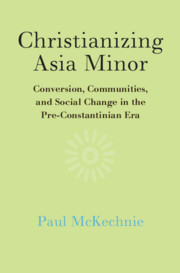Book contents
- Christianizing Asia Minor
- Christianizing Asia Minor
- Copyright page
- Contents
- Figures
- Abbreviations
- Preface
- Introduction
- 1 Phrygia in the New Testament
- 2 Hierapolis (Pamukkale)
- 3 Teachers of Asia: Ignatius, Polycarp, Paul and Thecla
- 4 Montanism Part 1: The Origins of the New Prophecy
- 5 Montanism Part 2: Pepuza and Tymion
- 6 Aberkios of Hierapolis (Koçhisar) and His Gravestone
- 7 Aberkios and the Vita Abercii
- 8 Apollonia (Uluborlu): Curiales and Their Families
- 9 Eumeneia (Işıklı) and the Eumeneian Formula
- 10 Christians for Christians
- 11 The Great Persecution and the Phrygian Fourth Century
- Book part
- Bibliography
- Index
Introduction
Published online by Cambridge University Press: 07 August 2019
- Christianizing Asia Minor
- Christianizing Asia Minor
- Copyright page
- Contents
- Figures
- Abbreviations
- Preface
- Introduction
- 1 Phrygia in the New Testament
- 2 Hierapolis (Pamukkale)
- 3 Teachers of Asia: Ignatius, Polycarp, Paul and Thecla
- 4 Montanism Part 1: The Origins of the New Prophecy
- 5 Montanism Part 2: Pepuza and Tymion
- 6 Aberkios of Hierapolis (Koçhisar) and His Gravestone
- 7 Aberkios and the Vita Abercii
- 8 Apollonia (Uluborlu): Curiales and Their Families
- 9 Eumeneia (Işıklı) and the Eumeneian Formula
- 10 Christians for Christians
- 11 The Great Persecution and the Phrygian Fourth Century
- Book part
- Bibliography
- Index
Summary
This book puts a periphery into the centre: it tells the story of the growth of Christianity in Asia Minor by taking the focus away from the cities of the coast and putting the up-country development of Asian Christianity, in Phrygia and neighbouring regions, at the heart of the narrative. Phrygia had a distinctive history from the sixth century BC onwards, having become a ‘highly fragmented, cellular agro-pastoral society’ (Peter Thonemann). Most of it fell within the large Roman province of Asia. There were cities, but few of them long established. The first Christian missionaries in Asia headed inland to a Phrygian region where the local language was still widely spoken – along with Greek, the language of the official and educational spheres. Some cities in the region were early adopters, in the sense of being among the first to bring the whole community under a Christian sacred canopy (Peter Berger). In the reign of Constantine, Orcistus (a Phrygian town) petitioned the emperor to grant city status – backing up the claim by saying that everyone in town was a ‘supporter of the most holy religion’ (Christianity). The success of the petition showed how much things had changed.
- Type
- Chapter
- Information
- Christianizing Asia MinorConversion, Communities, and Social Change in the Pre-Constantinian Era, pp. 1 - 17Publisher: Cambridge University PressPrint publication year: 2019

